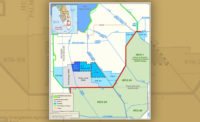
Mark Sudol
New regulations published by the U.S. Environmental Protection Agency and U.S. Army Corps of Engineers dramatically reduce federal protections of previously regulated streams and wetlands. This change will lead to further controversy and litigation as the legal terms are applied to physical features on the ground leading to conflicting interpretations by the regulated public, environmentalists and federal agencies.
Released in August, the rules are based on the Sackett case ruling by the U.S. Supreme Court in May. It held that federal agencies can no longer regulate bodies of water based on the “significant nexus” test. Under the new rules that now only cover federal jurisdiction waters—although states still have major regulatory roles—Corps authority involves waterbodies and tributaries that are “relatively permanent, standing, or continuously flowing.” For the Corps to regulate a body of water that includes any wetlands, it also must have a direct and continuous connection to a lake, river or similar body used for interstate or foreign commerce.
The impact will be substantial depending on location. In the arid Southwest, ephemeral streams that only flow after rainfall are no longer under Corps jurisdiction. Neither are playa lakes and vernal pools with no outlet.
There also will be important changes in permit regulations involving endangered species. Without jurisdiction over ephemeral streams, Corps officials will no longer have to consult with the U.S. Fish and Wildlife Service on endangered species impacts. Developers and members of the public must instead consult directly with the agency. Gone will be the consultation time limits typically in place between the Corps and FWS, resulting in likely delays.
The Midwest has fewer ephemeral streams, but there are substantial numbers that flow only part of the year as intermittent streams, supported by groundwater and rainfall. The Corps must now evaluate these on a case-by-case basis to determine if they are “relatively permanent.” This will result in greater complexity, a longer time to complete permits and potential regional differences in how the Corps makes its determinations.
Perhaps more importantly, most prairie potholes, shallow depressions filled by snowmelt and rainwater, will no longer be jurisdictional. These depressional wetlands are important as wildfowl breeding and feeding areas. The Northeast region also has many intermittent streams, bogs and fens that without a continuous surface connection won’t be jurisdictional.
I expect the Corps will soon begin processing requests for Approved Jurisdictional Determinations, known as AJDs, which were on hold after the Supreme Court decision. An AJD is a determination of the water features on a project site under Corps jurisdiction and are required for many permits. Corps regulatory professionals will need training and time to process backlogged AJDs. Delays will occur as Corps permit managers work through AJDs on hold since the court decision and then finish the associated permits. I anticipate delays of up to six months.
Another important issue involves applicants with projects approved under the previous standards and whether the court decision could “free them” from required costs. For permits issued within the last few months, and where work within waters has not started, the applicant may request a permit re-evaluation for possible jurisdictional change. If no longer jurisdictional, the permit can be modified to reduce impacts and potentially associated costly requirements such as mitigation.
In addition, for a permit application submitted but not approved, an applicant should validate if waters affected by a project are no longer governed by the new rule. For a new permit, the applicant should carefully re-evaluate water body status within the project area before submitting the application.
The Corps has finite resources and there will be many requests for a revised or new AJD, so delays are likely. The more an applicant coordinates transparently with the Corps and provides complete information for water features on a site, including photos, the more likely delay can be minimized.
Reactions from both the regulated public and the environmental community have not been positive. That usually means the rule is balanced, but future controversy as well as litigation seems inevitable.





Post a comment to this article
Report Abusive Comment